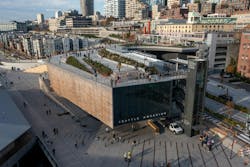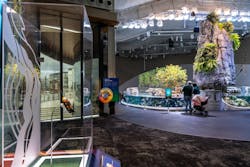Seattle Aquarium’s new pavilion integrates with the city’s urban waterfront
Aquariums are big draws around the country, and several are in the midst of or have recently completed expansion and renovation projects, ranging from San Diego’s Birch Aquarium’s transformation of its Hall of Fishes to a new exhibit called Living Seas, to Chicago’s Shedd Aquarium’s $500 million expansion, called Centennial Commitment, that’s scheduled for completion in 2027.
Five years after it broke ground, the Seattle Aquarium on August 29 opened its $170 million, 50,000-sf Ocean Pavilion whose 19 exhibits showcase more than 3,500 animals and plants. The pavilion’s centerpiece is The Reef, a 362,000-gallon biodiverse living habitat that’s visible from five perspectives. Also visible are some of the facility’s back-of-house operations that give visitors a taste of the sheer magnitude of running a 24/7/365 building whose “residents” and environs require constant attention.
The Ocean Pavilion is a component of a larger waterfront redevelopment that’s meant to link various iconic Seattle landmarks, such as its Pike Place Market, to the sea. The pavilion is located on solid ground at Piers 59 and 60, across the pedestrian promenade from two other piers. The pavilion’s construction occurred at the same time as two surrounding projects—the city’s Overlook Walk and Main Corridor—whose scope intertwines with the aquarium. This created logistical challenges that included cruise ship traffic driving through the jobsite for a summer season, according to Hanna Kato, AIA, CDT, LFA, LEED GA, Associate with LMN Architects, the pavilion’s design architect and AOR.
Thinc Design was the exhibits designer, PAE the MEP engineer, Turner Construction the GC, HLB Architects the lighting designer, Palazzo Lighting the lighting consultant, Teecom the technology consultant, Zoo Horticulture and Design the horticulture consultant, and Shiels Obletz Johnsen the development manager.
Kato says that she has been impressed with the pavilion’s “unique” conservation efforts that included its animal care team preparing the animals for their new habitat up to two years prior to the pavilion’s opening, according to a video that Seattle Aquarium posted on YouTube. It also took eight days to get the water that was pumped in from Puget Sound ready for the animals. That process entailed introducing water-cleansing bacteria that was cultivated within more than 500,000 “bio balls.” (The pavilion’s staff includes a water-quality team.) The facility is targeting LEED Gold and Zero Carbon certifications.
Lighting is nearly theatrical
This project illustrated the importance of design-build coordination to head off scheduling delays. For example, coordination allowed the pavilion’s construction team to pour the concrete for the 40-ft-deep tank and main exhibit gallery in a single 24-hour period.
Back-of-house infrastructure also required extensive planning. Unlike museums, entertainment centers, and art galleries, aquarium life-support systems operate all-day/everyday to maintain water quality and keep the animals alive. That regimen extends to chemical-resistant luminaires certified for wet locations to ensure the fixtures don’t fail, while performing at optimum light output. (Among the luminaires that the project specified were Kenall’s 18-inch-diameter ceiling-mounted SenScape lighting fixtures that can withstand a 1,000-hour salt spray test.)
Ben Kuritz, director of Architectural and Specification Sales at the manufacturer’s rep PLSWA, says that due to the large portion of lighting and controls integration required, PLS was hired to integrate multiple systems—lightng, HVAC, A/V, etc.—so that everyting could be controlled together. (ETC was the controls manufacturer.)
The Seattle Ocean Pavilion’s lighting choices throughout the facility, he observes, are “almost theatrical” in their function and placement. He notes, too, that the pavilion’s lighting accentuates the connection between land and water.
About the Author

John Caulfield
John Caulfield is Senior Editor with Building Design + Construction Magazine.


